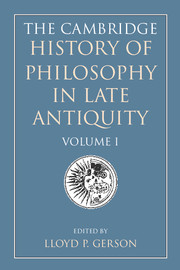Book contents
- Frontmatter
- General introduction
- I Philosophy in the later Roman Empire
- Introduction to Part I
- 1 The late Roman Empire from the Antonines to Constantine
- 2 The transmission of ancient wisdom: texts, doxographies, libraries
- 3 Cicero and the New Academy
- 4 Platonism before Plotinus
- 5 The Second Sophistic
- 6 Numenius of Apamea
- 7 Stoicism
- 8 Peripatetics
- 9 The Chaldaean Oracles
- 10 Gnosticism
- 11 Ptolemy
- 12 Galen
- II The first encounter of Judaism and Christianity with ancient Greek philosophy
- III Plotinus and the new Platonism
- IV Philosophy in the age of Constantine
- V The second encounter of Christianity with ancient Greek philosophy
- Map 1 The Byzantine Empire, c. 500
5 - The Second Sophistic
from I - Philosophy in the later Roman Empire
Published online by Cambridge University Press: 28 May 2011
- Frontmatter
- General introduction
- I Philosophy in the later Roman Empire
- Introduction to Part I
- 1 The late Roman Empire from the Antonines to Constantine
- 2 The transmission of ancient wisdom: texts, doxographies, libraries
- 3 Cicero and the New Academy
- 4 Platonism before Plotinus
- 5 The Second Sophistic
- 6 Numenius of Apamea
- 7 Stoicism
- 8 Peripatetics
- 9 The Chaldaean Oracles
- 10 Gnosticism
- 11 Ptolemy
- 12 Galen
- II The first encounter of Judaism and Christianity with ancient Greek philosophy
- III Plotinus and the new Platonism
- IV Philosophy in the age of Constantine
- V The second encounter of Christianity with ancient Greek philosophy
- Map 1 The Byzantine Empire, c. 500
Summary
LITERARY PLATONISM AND THE PLATONIC RHETOR
There was an interest in Plato in the first and second centuries ce that extended beyond the trends of summarizing and commentating on Platonic texts. This interest followed the established cultural tradition of orators and authors who were seen as emulators of sophists in the fifth century bce. In the so-called ‘Second Sophistic’, many of these men of letters took Plato, both as author and philosopher, to be their rhetorical and ideological model. The individuals at this time particularly influenced by Plato, roughly in chronological order, are Dio Chrysostom of Prusa, Publius Aelius Aristides of Mysia, Lucian of Samosata, Maximus of Tyre and Lucius Apuleius of Madaura. These individuals distinguished themselves from the scholastic tradition of Platonist studies that had developed in their various phases since Plato’s death.
Dio (c. 40–c. 120) was an early progenitor of this type of author, and his work exemplifies the resurgent and ubiquitous interest in Plato in non-Academic circles. In his speeches on behalf of rhetoric, Aristides (c. 117–81 ce), considered a paradigmatic sophist in the Common Era, shows how ‘direct’ communication with ‘Plato’ can be feigned six centuries after the Dialogues were written. Lucian’s (c. 125 – after 180) dialogues are a source of information about the sophists and philosophers who dominated the intellectual world during the mid-Empire, and are themselves modelled after particular Platonic dialogues. Maximus’ (c. 125–c. 180) Dialexeis has become an important source for understanding the role of a public Platonist in the second century.
Keywords
- Type
- Chapter
- Information
- The Cambridge History of Philosophy in Late Antiquity , pp. 100 - 114Publisher: Cambridge University PressPrint publication year: 2000

